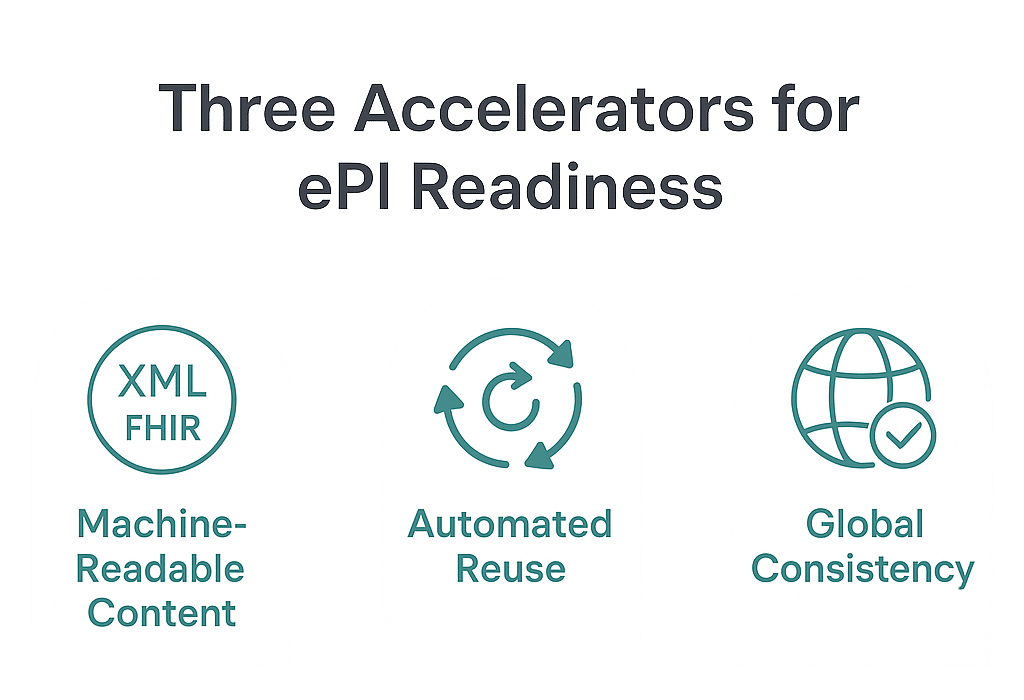Electronic Product Information (ePI) represents more than a digital facelift for pharmaceutical documents. It’s a regulatory transformation—one that expects patient- and regulator-facing information to be accessible, structured, and machine-readable from the outset. The European Medicines Agency (EMA), Health Canada, and other agencies are rapidly moving to digital-first, modular ePI formats. This shift demands new ways of thinking about how content is authored, reviewed, and maintained.

Many life sciences companies are approaching ePI as a formatting challenge. But that’s a narrow interpretation—and a costly one. The real bottleneck isn’t in rendering the XML. It’s in preparing narrative content that is structured, consistent, and ready to be rendered automatically and accurately.
Structured content authoring (SCA)—especially when AI-powered—is the operational key to accelerating ePI readiness. It addresses the root causes of delays and quality issues, not just the symptoms. Below are three ways SCA platforms like Docuvera help regulatory, labeling, and medical affairs teams meet the demands of ePI efficiently and sustainably.
1. Structured Content Enables Format Flexibility at Scale
At the heart of ePI is the need to deliver product information in structured XML, HTML, and digital formats that can be read by both humans and machines. But most pharmaceutical content is still written in Microsoft Word, stored in PDF, and manually rekeyed or reformatted during finalization.
This document-centric process is brittle and unscalable. Every update—whether it’s a dosage change, contraindication update, or safety signal—requires manual formatting, restructuring, and versioning to meet agency specs.
Structured content authoring eliminates these formatting delays by:
Creating modular content blocks that are already tagged with metadata
Maintaining a single source of truth that can be rendered into multiple output formats (PDF, XML, HTML, FHIR)
Automating the transformation of content into machine-readable layouts based on regulatory specifications
With Docuvera, for example, authors work in a familiar interface while content is structured behind the scenes. Outputs are generated automatically—no separate formatting cycles or conversion vendors required. This format agility reduces turnaround time from weeks to hours and ensures consistency across formats.
In a landscape where regulators may mandate XML delivery within tight timeframes, this capability is not just useful—it’s necessary.
2. Modular Content Makes Multilingual Management Practical
Pharmaceutical product information is typically localized for dozens of global markets. For SmPCs, PLs, and labeling documents, that means managing the same core content across multiple language variants and regional adaptations.
In a document-based world, every version becomes its own artifact. Updating a product warning in one language means searching for all equivalent files, coordinating with country affiliates, validating translations, and redoing formatting. The risk of inconsistencies—both factual and stylistic—is high.
Structured content solves this through true reuse:
Core modules (e.g., indications, adverse effects, usage instructions) are created once and reused across all markets
Translations are linked at the component level, so updates to the source trigger notifications across language variants
AI tools assist in identifying which markets or modules need synchronization
For ePI, where information must be globally aligned and dynamically rendered for patient portals or public databases, this modular approach is essential.
Docuvera’s AI-powered platform goes further—suggesting reuse across similar product lines, flagging outdated language, and ensuring that every localization is based on the current global baseline. This reduces redundant work while improving global content quality.
3. Metadata-Rich Components Improve Traceability and Compliance
One of the least discussed but most important aspects of ePI readiness is traceability. Regulatory teams must demonstrate that product information is current, approved, and linked to source data (e.g., IDMP attributes, structured labeling fields). When content exists as standalone Word files or embedded PDFs, traceability becomes a spreadsheet-based nightmare.
Structured content embeds traceability into the authoring process:
Each component is tagged with metadata that defines its purpose, regulatory status, region, version, and approval history
Changes are tracked at the component level—not the document level—enabling faster, targeted reviews
Teams can see where a content block is reused, who approved it, and whether it is synchronized with structured data elements
This capability becomes critical as health authorities adopt electronic validation steps. If the same safety statement appears in both an ePI and a summary of product characteristics, regulators expect it to match exactly—and to understand why it changed if it doesn’t.
Docuvera automatically maintains audit trails, tracks reuse, and supports reconciliation across outputs. With AI assistance, the platform also surfaces inconsistencies and suggests updates before content is published—reducing the chance of non-compliance or post-submission correction requests.
ePI Readiness Is Not a Formatting Project—It’s a Structural One
Too often, life sciences companies treat ePI as a content delivery problem. But focusing on delivery without rethinking the upstream authoring model results in rework, delay, and compliance risk.
True ePI readiness starts with structured content. It means rearchitecting content so it’s modular, machine-readable, and traceable from day one. It means building a content model that supports multilingual alignment, reuse across indications and regions, and synchronized updates based on regulatory triggers.
This doesn’t require disruption. It requires intent.
Start with core product information. Identify the content most frequently reused. Implement a structured content platform that your teams can use without IT intervention. Use AI to automate the labor-intensive parts—reuse detection, metadata tagging, change propagation.
Conclusion
The regulatory trend toward ePI is clear. EMA’s implementation is underway. Other agencies are piloting similar frameworks. These efforts share one foundational assumption: that content is structured, validated, and ready to render at speed.
If your current content lives in disconnected documents, you won’t be ready.
Structured content authoring makes ePI readiness possible. AI-powered platforms like Docuvera make it scalable. By transforming how content is created—not just how it’s formatted—companies can meet ePI requirements with confidence, speed, and control.
ePI is not the future. It’s happening now. The question is whether your content is ready to keep up.